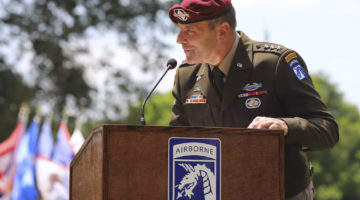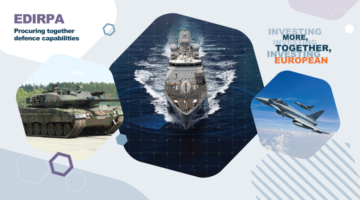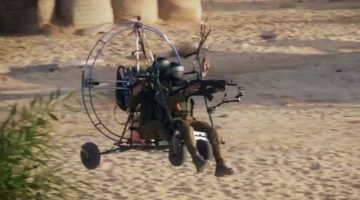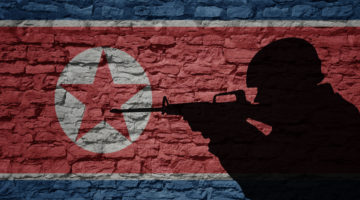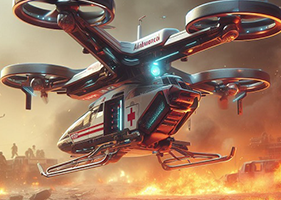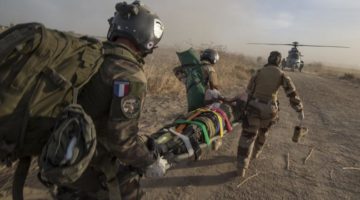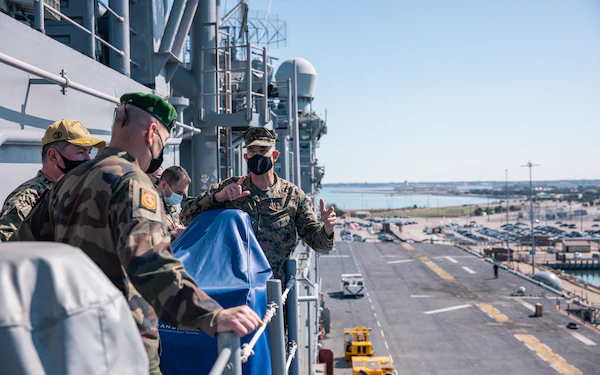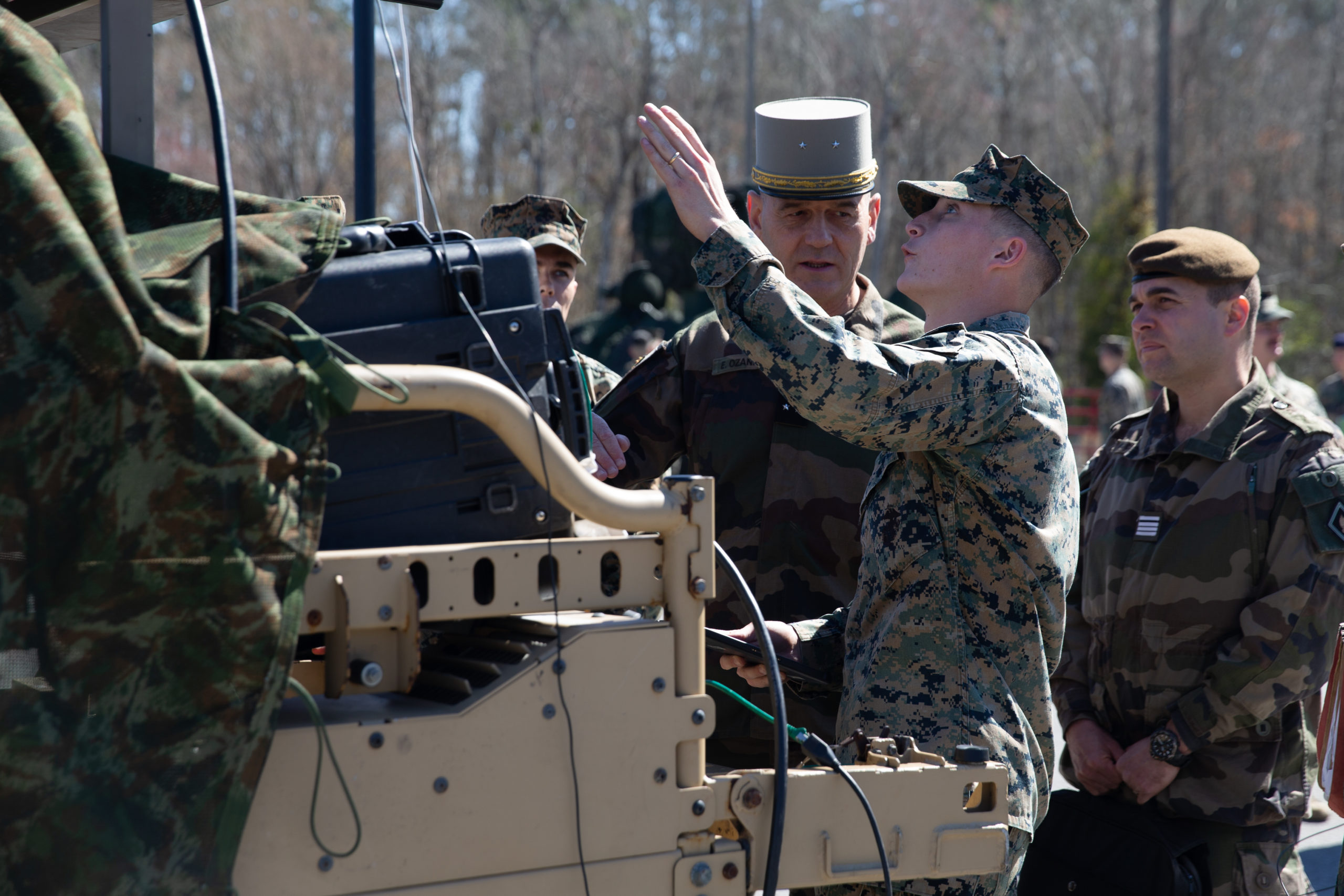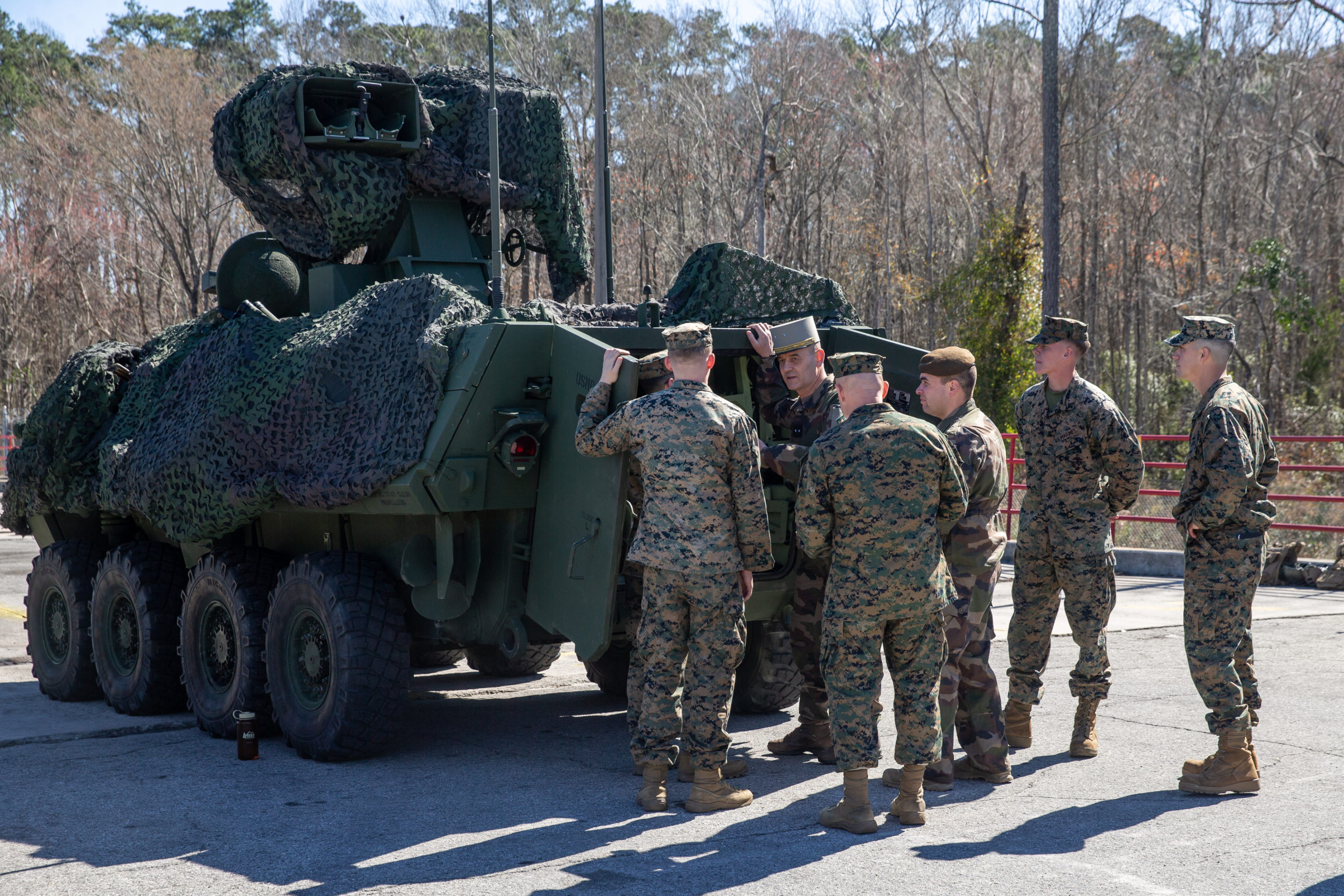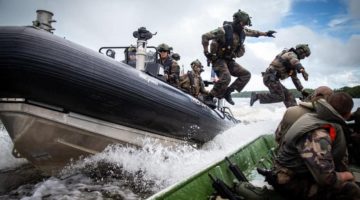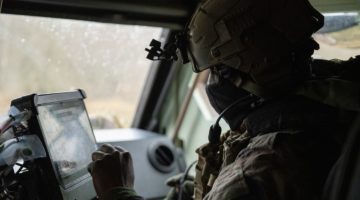By Murielle Delaporte – This is a long version of an article published by the US website Breaking Defense during the current Modern Day Marine 2022 >>> https://breakingdefense.com/2022/05/what-the-us-marines-can-learn-from-a-french-army-sister-unit/
To follow next month is a French version to be published in our upcoming Eurosatory issue of Opérationnels SLDS # 55 -56.
***
Last month, U.S. Marine Corps Maj.Gen. Francis F. Donovan, 2nd Marine Division (2ndMarDiv) commanding general, welcomed French Army Brig. Gen. Eric Ozanne, 6th Light Armored Brigade (LAB) commanding general, for a four-day visit of various military installations along the East Coast, from USMC Camp Lejeune, North Carolina, to the USS Kearsarge at Naval Air Station in Norfolk, Virginia.
We had a chance to interview Brig. Gen. Ozanne at the end of a visit meant to enhance the understanding and the relationship between his brigade – the ‘’6th’’ – and 2nd MarDiv, which have been paired as sister units since 2019.
Photos © USMC (click on picture to see credit details)
At the origins of the pairing : common amphibious roots
‘’The partnership between the 6th and 2nd MarDiv can actually be traced back to 2013, when USMC Commander James F. Amos the French chief of staff of the Army, gen. Bertrand Ract-Madoux signed a memorandum of understanding (MOU) to enhance the relationship between the two services’’, explains brigadier general Ozanne, who organized the very first exercise between the two sister units the year after, as he was commanding the 2nd REI (Régiment étranger d’infanterie), i.e. the 2nd Foreign Legion Infantry Regiment.
A Legionnaire since the beginning of his military career, Bgen Ozanne has been constantly deployed in the Balkans, Afghanistan and Africa, and more often than not along with the U.S. Marines, as well as the U.S. Army.
So why having partnered with the U.S. Marine Corps and not with the U.S. Army ?
‘’Being deployed side by side does play a major role’’, the general says, ‘’but the main reasons lie in the similitude of our modus operandi as well as our amphibious characteristic which constitutes the cornerstone of our relationship.’’
The 6th LAB, which the general commands since last August, does indeed include, in addition to four Foreign Legion regiments (1e REC ; 2e REI ; 13e DBLE ; 1e REG) and the 1st Spahis regiment (1e RS), two Marine regiments – one infantry, the other artillery – (21e RIMA and 3e RAMA).
‘’Beyond the fact that we are both embarked military forces and forcible entry capabilities, I find that a lot of similarities exist among ourselves, starting with our size.’’ Indeed the 2nd MarDiv, which is the ground combat element of the II Marine Expeditionary Force (II MEF), counts 13,000 men according to Major general Francis L. Donovan, while the 6th counts 8,000.
‘’Beyond the concept, there are the organization and the way we function. Strengthening our interoperability is not only a matter of equipment, but has to be done across the board in every domain from doctrine to support. And starting with the basics, i.e. language… In combat or in the field, you always go back to your native tongue. So one should not forget that the very first barrier to interoperability remains the ability to communicate in the same language.’’
An obstacle that multiple exchanges on both sides of the Atlantic (e.g. joint training of the 3rd RAMA and a Marine artillery section in France ; integration of the 2nd REI in a USMC Battalion ; etc.) and multiple exercises (such as Bold alligator on the US side or Baccarat[1] on the French side) are succeeding to erase in part, as ‘’it is difficult to have all echelons in a French regiment to speak English’’.
Training regularly and learning from each other on a permanent basis like the two sides have been doing in recent years is crucial. Even though U.S. Marines and French Infantry do operate in similar ways, they tend to maneuver, use support, digitalize, and command the troops a bit differently.
Indeed Maj. Gen Donovan has expressed interests in getting to know the French organizational structure, as this is where major cultural differences lie :
‘’on the basis of our bilateral discussions during this visit, I would say the French way of commanding the troops is attracting interest in the sense that, contrary to U.S. bases which resemble large cities and where troops live rather dispersed, French soldiers live side by side on a daily basis. This sense of collectivity in everyday life – and not only during training, operations or ceremonies – is what creates the esprit de corps at the regiment level’’, stresses the 6th commander.
An esprit de corps, which, for him, is the very first requirement to be able to fight and win a war against any enemy, but especially as both the Marines and the French Army have now to prepare to fight in a peer-to-peer confrontation.
‘’We always trained very hard following the motto ‘’hard training, easy war’’, but what we are currently doing is retrain ourselves to face an enemy with the same capacities as we have. And the first thing we need to learn is how to cope with massive losses in men and equipment. That is where forging a collective moral force embodied in the esprit de corps at the regiment level is absolutely and literally vital,’’ Bgen. Ozanne reminds us.
Transitioning from Counter-Insurgency To Peer (or Near Peer)-To-Peer Engagement
During these past decades, counter-insurgency operations dominated, a period during which both U.S. and French embarked forces did loose their amphibious expertise. They have been starting to re-learn it starting in 2012 with the first Bold Alligator exercise held off the Virginia and North Carolina coast, where French forces participated for the first time.
The USMC commander’s Concept for Stand-In Forces (SIF) and the recent creation of three Marine Littoral Regiments (MLRs) are part of the current proposed Marines’ transformation path and transition towards facing the new threats (especially in the Pacific where two-thirds of the Marines are assigned, but not only). Phase III Service-Level Infantry Battalion Experiment Campaign Plan – referred to as IBX30 – is meant to assess the functionality of the FD2030 Infantry battalion design[2].
In this month’s issue of Proceedings, USMC general Eric Smith describes this concept as follows :
‘’Stand-in forces are units that are task-organized, trained, and equipped to disrupt an adversary’s plans at every point on the competition continuum. They are strategically placed where they can collect targeting data, strike to close choke points, or herd adversaries into areas where U.S. naval and joint forces can bring more weapons to bear. These light, highly mobile forces have capabilities that will force an adversary to deal with a unit that previously would have been too small to care about. They can persist independently for days if needed and can reposition with organic mobility assets to avoid being targeted. Their physical and electromagnetic signatures are so low they are not easily detected, and if detected, they possess the lethality to fight.’’[3]
High mobility is indeed the second asset both U.S. and French forces are focusing on for three reasons:
- the ability of a peer enemy to strike in depth and the end of the air superiority enjoyed in previous theaters;
- the ability of the enemy to use counter-mobility means and the necessity to re-train some of the tactics that today’s commanding officers last practiced when in military schools at the end of the Cold war, including maneuvering in a NRBC environment;
- the technology push of new equipment revolutionizing the order of battle.
The 6th has indeed been at the forefront of such a transformation – and Bgen. Ozanne in particular throughout his military career – since the brigade has been experimenting a digitalization process referred to as NEB (for ‘’Numérisation de l’espace de bataille’’) for the past twenty years and since it will be the very first brigade to be fully modernized with new-generation Scorpion equipment and deployable as such in 2023.
‘’The Griffon [new infantry armored vehicle[4]] -SICS [new Scorpion Information and C2 System[5]] tandem is a true success and provides our tactical command posts with an unprecedented agility which revolutionizes the tempo of maneuver. We now enjoy a fluidity and permanence in command we never had before.’’
Mobility does contribute to survivability in a high intensity conflict – or a ‘’major engagement’’ as the French military leadership refers to it -, as much as discretion and protection, but re-training is needed to ‘’get rid of bad habits adopted during counter-insurgency operations when command posts were fixed and commanding was for that reason much easier”, Bgen. Ozanne says.
In the US Navy – US Marine Corps official document explaining the Concept for SIF initiated by gen. David S. Berger, commander of the US Marine Corps, survivability is described as follows:
‘’ Survivability SIF are designed to survive inside a contested area through the application of a “hard to find—hard to kill” approach (…) SIF achieve a light footprint in part by automating functions traditionally performed by people to reduce the number of Marines needed to operate effectively. For example, automating a fire support task could result in the reduction of required watch standers, which then reduces the amount of life support and mobility needed. Design aspects of this approach may include production, exploitation, and dissemination (PED) of intelligence, fire support tasks, logistics delivery, etc.’’[6]
This return to a more infantry-centric approach is where the US Marines and the French Army brigade meets as well, but with slightly different emphasis : whereas the USMC under the current commandant bets on footprint lightness, agility and high tech (even getting rid of hundreds of tanks and of two of its five helicopter squadrons), to re-differentiate itself from the U.S. Army, the French Army re-differentiate itself by putting an end to the multi-role characteristic of brigades till now dedicated to counter-insurgency.
‘’The Marines and the French Army came up with the same conclusion, i.e. that we cannot ‘’do it all’’ in the new threat environment. Following a process initiated by gen. Burkhard, the French chief of staff when he was chief of staff of the Army, brigades are going to be specialized again into the traditional three segments, i.e. armored (with VBCI and Leclerc), median (with Griffon and the new Jaguar to be incorporated in cavalry units for the first time this year) and light brigades (with Serval and Jaguar as well). High intensity calls for such a return to differenciation. Rerolling is not feasible anymore and you can actually already see it on some theaters of operations such as in Estonia, where VBCI-Leclerc groups for instance self-rotate on a regular basis to contribute to NATO’s Enhanced Forward presence with the Lynx mission…’’, Bgen Ozanne explains.
If the current partnership between the franco-american amphibious sister units works well with a decentralization based on a pairing between French regiments and Marines’ sections, both Ozanne and Donovan want to boost it at the chief of staffs’level. A prospect made possible thanks to massive investments on both sides in new distributed simulation capabilities. Indeed, the Marine Corps Warfighting Laboratory (MCWL) IBX30 assessment plan does rely heavily on Wargaming and Modeling and Simulation studies. ‘’These new capabilities are especially usefull to develop high intensity warfare tactics, especially when simulating large losses, but can only be used as a complement to live training’’, stresses Bgen Ozanne.
Lieutenant general Brian D. Beaudreault, who retired last July as II MEF commander and who also commanded the 2nd MarDiv, agrees with such a need for deeper integration and interdependence. Having been a strong proponent of the bilateral rapprochement, he considers such a combined force capability an imperative :
‘”When I was the CG of II MEF, I felt that we needed to aim for more than just interoperability but rather interdependence. That required a greater degree of trust than interoperability, but trust is the glue that holds relationships together.”
‘’I didn’t just desire to work with this close ally because of similar structures and ties to amphibiosity but it was an imperative to do so. This combined capability in addition to what the British and Norwegians would commit enhanced all of our deterrence objectives and was a substantive effort to prepare for high end combat while security conditions afforded us the opportunity to do so. Beyond adding greater capacity in the force which will yield greater resiliency in times of high casualties, the 6th LAB would bring incredibly important capabilities to the fight that the Div didn’t possess such as armor. There was the multiplicative aspects of redundant capabilities which increases a commander’s flexibility in maneuvering forces but also expands his options when an ally is bringing in a capability that is a true gap filler that also can be self sustaining, execute its own independent C2, have its own organic fires, etc…’’
‘’I am thrilled to see the relationship continuing to mature,’’, the Lt.gen. told us, ‘’and I believe there is reason for great optimism on further improving upon our interoperability (and interdependence) goals. After setting a plan in motion in 2020 when I was CG II MEF, I was excited to see the recent announcement of the establishment of Task Force 61/2 in Italy with the merger of Naval Amphibious Forces Europe with 2d MARDIV. This is an excellent initiative that more closely aligns our own Navy and Marine Corps team in Europe but now provides a naval HQ that can reach out to allies and partners in Europe, such as the 6th LAB and begin to more deeply integrate exercise plans and schedules well in to the out years and where more sophisticated training objectives become possible as the campaign of learning drives future activities.’’
‘’The future outlook of this combined force capability is indeed bright and will certainly prove to be a strong deterrent force. Should deterrence fail, 6th LAB and 2d MARDIV fighting under a consolidated C2 construct is a force that is highly ready to fight and win while operating side by side,’’ Lt. gen. Beaudreault concluded.
Footnotes
[1] https://archives.defense.gouv.fr/terre/actu-terre/baccarat-21-l-aerocombat-pour-conserver-sa-liberte-d-action
[2] To access the PDF >>> FD2030-Infantry-Battalion-Experimentation
[3] https://www.usni.org/magazines/proceedings/2022/april/stand-forces-adapt-or-perish
[4] https://www.defense.gouv.fr/terre/dossier-programme-scorpion/griffon
[5] https://archives.defense.gouv.fr/terre/equipements/equipements/commandement-transmissions/sics
[6] To access the PDF >>> A Concept for Stand-In Forces
Photo: French Army Brig. Gen. Eric Ozanne, 6th Light Armored Brigade (LAB) commanding general, tours the USS Kearsarge at Naval Air Station Norfolk, Virginia, March 2, 2022 © Staff Sgt. Akeel Austin, USMC

